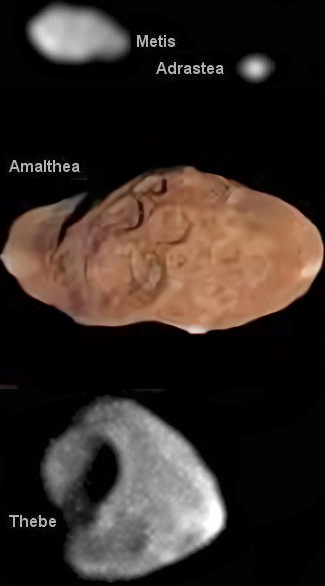

Solar System -
Jupiter's Moons
Inner Moons
The inner moons of Jupiter comprise Metis, Adrastea, Amalthea, and Thebe. They orbit inside the orbit of Io, the first of the Galilean moons, and all rotate on their axes in the same time as they orbit Jupiter. All the inner moons contribute material to Jupiter's ring system. Being so small, they have very low escape velocities which allows material to escape following micrometeorite collisions.
Metis
Metis was discovered in March 1979 by the Voyager science team, and is Jupiter's closest moon at 128,000 km away, so is only about 58,000 km above Jupiter's surface. It takes just 7 hours 4.5 minutes to make one orbit around Jupiter. It orbits in a gap withing the Main Ring, and itself contributes material to the rings. At 60 x 40 x 34 km, it is small and irregular, and is made mainly from water ice.
Adrastea
Discovered in 1979, Adrastea is the smallest of the inner moons at 20 x 16 x 14 km. It orbits at a distance of 129,000 km, at the outer edge of Jupiter's Main Ring, to which it is the major contributor. It takes 7 hours 9.5 minutes to make one orbit around Jupiter, just five minutes longer than Metis. Like Metis, Adrastea's orbit is slowly decaying due to tidal forces, and it will eventually fall into Jupiter.
Amalthea
Amalthea was discovered on September 9, 1892. It orbits Jupiter in a slightly eccentric orbit once every 11 hours 57 minutes 23 seconds. It is 181,150 km away at its closest and 182,840 km at its furthest. It is within the "Amalthea Gossamer Ring" that results from material coming from its surface.
It is very irregularly shaped being about 250 x 146 x 128 km. Jupiter would be an impressive sight in its sky at 92 times larger, and 900 times brighter than full moon on Earth. It is composed mainly of water ice, with some additional material including sulfur, and is very porous. For its size, it has some enormous craters, Pan is 100 km across and at least 8 km deep, while Gaea is 80 km across and possibly 15 km deep. Two prominent mountains, Lyctas and Ida, are up to 20 km high.
Thebe
Also discovered in 1979, Thebe's orbit is rather more eccentric than the other inner satellites due to the influence of nearby Io. Its orbit varies between 218,000 and 226,000 km and takes 16 hours 11 minutes and 18 seconds. Irregularly shaped, like all the iner moons, it is 116 x 98 x 84 km. It orbits near the outer edge of the Thebe Gossamer Ring, which is composed of material ejected from Thebe. It has a crater called Zethus which is ~40 km across.
Inner Moons • Io • Europa • Ganymede • Callisto • Himalia Group • Carme Group • Ananke Group • Pasiphae Group • Miscellaneous
Jupiter's moons are grouped as follows. Select to see details of the moon or the group of moons:

